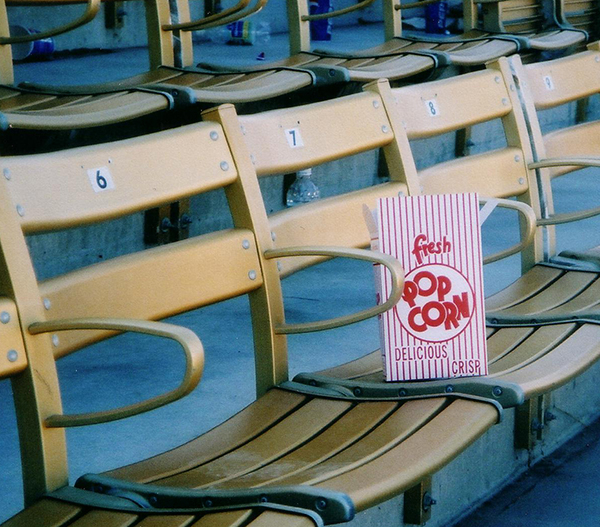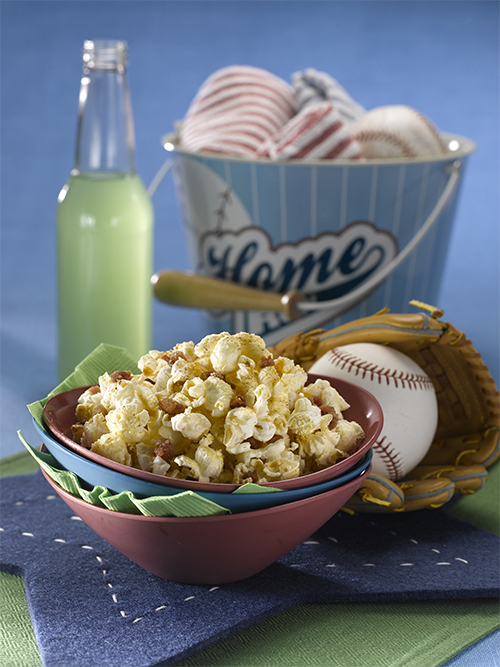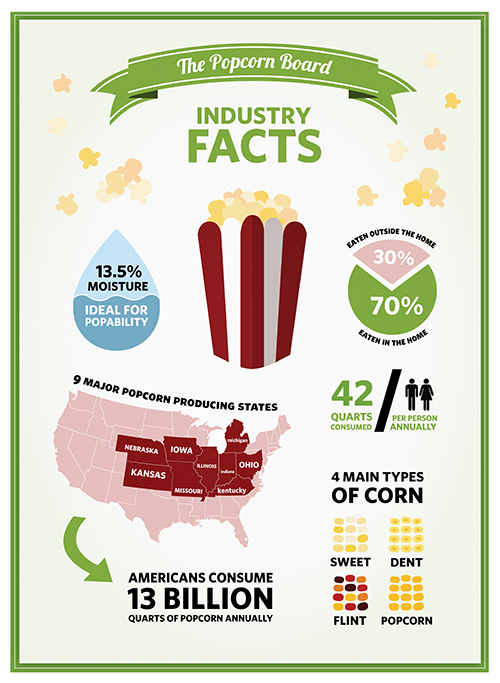
USA National Popcorn month is October. (It was established 30 years ago by the Popcorn Board.) National Popcorn Day is 19 January and Popcorn Lover’s Day is celebrated on March 12. Decidedly America loves popcorn and so does FUSAC.
Corn itself is very American and goes way back before the first Thanksgiving. There is archaeological evidence that popcorn was available in Central America 9000 years ago. Popcorn was an important food for the Aztec Indians, who also used popcorn as decoration for ceremonial headdresses, necklaces and ornaments on statues of their gods. Americans today grow and eat lots of corn and most of the snack foods they eat are corn based. This is different from France where many snacks are potato based.
Popcorn is scientifically known as Zea mays everta. Popcorn is a whole grain and is made up of three components: the germ, endosperm, and pericarp or hull. The 4 most common types of corn are: sweet, that you can eat right off the cob; dent, more commonly called field corn and used for animal fodder; flint or « Indian corn » and popcorn. But only popcorn pops! Popcorn differs from other types of corn in that its hull has just the right thickness to allow it to burst open. It must also have just the right moisture content, because it is the moisture that makes the pop.
“As the kernel heats up, the water begins to expand. Around 212 degrees the water turns into steam and changes the starch inside each kernel into a superhot gelatinous goop. The kernel continues to heat to about 347 degrees. The pressure inside the grain will reach 135 pounds per square inch before finally bursting the hull open. As it explodes, steam inside the kernel is released. The soft starch inside becomes inflated and spills out, cooling immediately and forming into the odd shape we know and love. A kernel will swell 40-50 times its original size!” from https://www.popcorn.org/Learning/Science-Fair-Projects
Ella Kellogg (the same Kellogg of breakfast cereal!) enjoyed her popcorn ground with milk or cream. Although she discouraged in-between meal snacking, she urged others to eat popcorn at meals as popcorn was “an excellent food.” Ella understood, as her husband did, that popcorn was a whole-grain. John Harvey Kellogg praised popcorn as being “easily digestible and to the highest degree wholesome, presenting the grain in its entirety.” Of course they went on to create Kellogg’s Corn Flakes.
Popcorn’s POP-ularity spiked with the invention of first popcorn popper in the 1830s. In 1893 Charles C. Cretors developed the first mobile popcorn machine, making bulk manufacture of the snack a possibility. The Cretors family still owns and operates the company today. Thanks to them there were popcorn wagons at most community events. As time went on it became POP-ular at the new motion picture shows and has become the quintessential movie snack. Unlike other confections, popcorn sales increased throughout the Depression. A major reason for this increase was the introduction of popcorn into movie theatres and its low cost for both patron and owner.

Cretors’ popcorn wagon
Americans today eat popcorn sold as fund raisers by the Boy Scouts, from dedicated shops in malls, at the snack counter of Target and from popcorn carts (often for free) in hardware stores and sometimes banks! Once in the USA we even had some popcorn served in a restaurant as part of a « café gourmand ». They give popcorn as gifts, make craft or science projects with it and sometimes use it instead of styrofoam peanuts. Popcorn poppers are found at home, in dorm rooms, stadiums and church kitchens. Americans consume 14 billion quarts (liters) of popcorn annually, that’s 43 per person. Yes the US is crazy about popcorn.
Part of popcorn’s seduction is its simplicity. No exact recipe or measurements are needed. Just a little oil in a pan, heat, add enough kernels to cover the bottom in a single layer, cover and shake. When the popping slows remove it from the heat. Then you can add toppings. Here’s one suggestion :
For a savory topping:
- 1 tablespoon brown sugar, tablespoon paprika, teaspoon dry mustard, 1 teaspoon salt, 1 teaspoon chili powder, 1 teaspoon garlic powder, 1 teaspoon onion powder, 1 teaspoon cumin, 1/2 teaspoon cardamom, 1/2 teaspoon celery salt, 1/4 teaspoon cayenne pepper
Directions
- Mix ingredients together in a small bowl. Store mixture in an airtight container.
- To use: melt some unsalted butter, add seasoning to butter then toss with popcorn. Use about 2 teaspoons of seasoning mix for each quart of popcorn. By the way, 2 tablespoons of unpopped popcorn makes a quart.
Two less conventional ways to use popcorn are Cheesy popcorn bread or Cranberry Almond Popcorn muffins. You can find those recipes and others here: https://www.popcorn.org/

Popcorn in France
Popcorn was first introduced to France by Buffalo Bill’s Wild West show at the end of the 19th century. Movie theatres here serve popcorn as well although the popcorn in French theatres it is usually eaten with sugar rather than salt and butter.
In 2016 Scarlett Johansson opened a popcorn shop in the Marais. But it didn’t last long. “It has been a dream of mine and my family for several years to bring our favorite American snack to our favorite European City!” – Scarlet Johansson. With all that enthusiasm why didn’t it last? Perhaps 6€ a bag, albeit an America-sized bag, was too expensive?
My Crazy Pop had a boutique in the 11th. And that too is gone. But they do seem to have continued to do online and corporate sales for events from their new space in St Maur des Fosses. Their modus operandi, which is very French, is to sublimate popcorn. They use hot air popping methods and make Frenchified flavors like raspberry, chorizo and piment d’espelette, caramel vanilla, green apple and cinnamon, chocolate.,, You get the picture.
Papy Popcorn, made in Les Vosges mountains has a few retailers in Paris. But it is timid.
The Real McCoy sells microwave and kernel popcorn imported from the States. Plus they carry Cracker Jack (created in 1896) – popcorn and peanuts coated in molasses caramel in a box with a prize inside. You can find them at 194 rue de Grenelle 75007.
Did you know:
- Popcorn kernels can pop three feet in the air! That’s why you pop it with a lid on!
- Popcorn is very low in calories compared to other snacks, especially if it is air popped without oil
- Most popcorn is grown in the Midwest, primarily in Indiana, Nebraska, Ohio, Illinois, Iowa, Kentucky and Missouri.
- Most popcorn comes in two basic shapes when it’s popped: snowflake and mushroom. Snowflake is used in movie theaters and ballparks because it looks and pops bigger. Mushroom is used for candy confections because it doesn’t crumble.
- Popping popcorn is one of the number one uses for microwave ovens.
- If you made a trail of popcorn from New York City to Los Angeles you’d need 352,028,160 pieces.
- The world’s largest popcorn ball, according to Guinness World Records 2015, was created in 2013 at the Indiana State Fair. With the help of Pop Weaver, Snax in Pax, and Indiana’s Family of Farmers, the popcorn ball weighed in at 6,510-pounds, 8 feet in diameter. So there!


